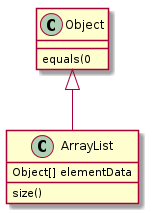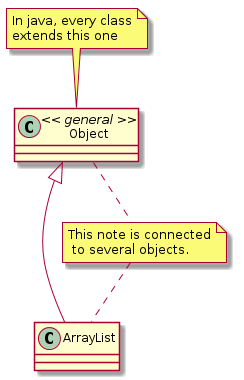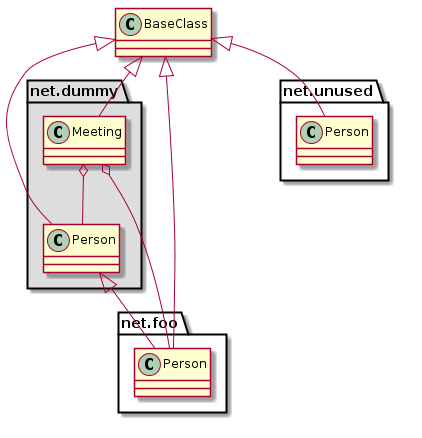[emacs] Drawing uml under emacs org-mode using plantUML - 类图
[emacs] Drawing uml under emacs org-mode using plantUML - 类图
Table of Contents
1 准备工作
1.1 org-mode学习入门的相关资料
1.2 搭建plantuml环境
- 安装plantuml, 参考
- 下载相关lisp文件, ob-plantuml.el
- 将plantuml的安装路径, 加入到
ob-plantuml.el文件中# line 44 (defcustom org-plantuml-jar-path "/your/install/path/plantuml.jar" "Path to the plantuml.jar file." :group 'org-babel :version "24.1" :type 'string)
- 将
(require 'ob-plantuml)加入到init.el或是.emacs内
1.3 先爽一下
当上述的工作都完成之后, 就可以happy的使用plantuml这个神奇的工具了. 需要编辑的代码如下:
Alice -> Bob: Authentication Request Bob --> Alice: Authentication Response
在上述代码内部使用 <ctrl-c> <ctrl-c> 的快捷键就能够在下面获得相应的图像. 是不是很爽呀, ;)

2 PlantUML使用说明
2.1 PlantUML 简介
PlantUML 允许使用简单的直观的语言实现, 能够用来绘制:
- 序列图
- 用例
- 类图
- 行为图
- 结构图
- 状态图
- 对象图
2.2 类图
由于对于一个程序员而言, 类的设计相对于其他的绘图而言更为重要, 因此此处首先介绍了plantUML在类图绘制中的使用方法
2.2.1 类之间的关系
此处, 类之间的关系以及所使用的符号如下:
| 联合, association | <– |
| 扩展, extension | <(竖线)– |
| 组成, composition | *– |
| 聚集, agregation | o– |
-- 替换成 .. 就能够获得相应的点线, 其中一个短线"<-"表示横向, 两个短线"<–"表示竖向
对于上述的关系表示非常困惑, 不急, 慢慢看来, ;)
- Association 1 2 有两个类, A 和 B, 如果A够根据将消息发送给B, 或是B的实例能够影响A, 那么就称两者之间的关系为Association, 并且在一般情况下两者是相互的. 如下所示:
class class1 as "A" class class2 as "B" class1 --> class2

class B {...} class A { B* itsB; }
- extension3, 也被称为继承关系, 或is-a关系.
class food { }; class apple : public food{ };上面的关系就可以理解为, apple是food
class class1 as "food" class class2 as "apple" class2 --|> class1

- composition and aggregation. 对于这两者的理解wikpedia中有一段很好的描述 4:
一个大学里面有很多的学院, 每个学院又有很多的教授. 当这个大学倒闭关门的时候, 原来存在的学院也就随着大学的关门而不存在了, 但是这些教授却依然活着. 因此, 学校是由学院组成的, 即compostition, 学院是教授的集合地, aggregation
class Professor; class Department { private: // Aggregation Professor* members[5]; }; class University { private: std::vector<Department> faculty; create_dept() { // Composition faculty.push_back(Department()); faculty.push_back(Department()); } };class class1 as "University" class class2 as "Department" class class3 as "Professor" class3 -right--o class2 class2 -right--* class1

2.2.2 添加label
在关系的后面加个":", 而后添加相应的label, 在连接符两边用""可以添加对应类的label, 如
Class01 "1" *-- "many" Class02 : contains Class03 o-- Class04 : agregation

2.2.3 添加方法
在类名后面添加":", 如:
Object <|-- ArrayList Object : equals(0 ArrayList : Object[] elementData ArrayList : size()

另一种方法为:
class Dummy {
String data
void methods()
}

在类中添加不同的方法的时候, 往往需要给出相应的方法的属性, 如private, protected, public等:
| - | private |
| # | protected |
| ~ | package private |
| + | public |

2.2.4 注释以及定型
对图中的类进行注释, 采用"..", 定型(即, 给类一个特定的分类), 采用""和" ".

在注释中还可以使用html标签对注释的内容的格式进行美化.
- <b> 加粗
- <u> 加下划线
- <i> 斜体
- <s>, <del>, <strike> 删除线
- <font color="#AAAAAA"> or <font color="colorname"> 字体颜色
- <color:#AAAAAA> or <color:colorName> 字体颜色
- <size: nn> 字体大小
- <img src="file"> or <img:file> 添加图片
note top of Object In java, every <u>class</u> <b>extends</b> <i>this</i> one end note note as N1 This <size:10>note</size> is <u>also</u> <b><color:royalBlue>on several</color></b> <s>words</s> lines end note

2.2.5 抽象类以及接口
抽象类使用"abstract"或"abstract class"关键字, 接口用"interface"关键字, 枚举用"enum"关键字
abstract class AbstractList abstract AbstractConllection interface List interface Collection List <|-- AbstractList Collection <|-- AbstractConllection Collection <|- List AbstractConllection <|- AbstractList AbstractList <|- ArrayList ArrayList : Object[] elementData ArrayList : size() enum TimeUnit TimeUnit : DAYS TimeUnit : HOURS TimeUnit : MINUTES

2.2.6 方法属性的隐藏
可以使用 "hide/show" 命令实现对方法以及属性的隐藏, 常用的命令如下:
- hide empty members
- hide empty fields or hide empty attributes
- hide fields or hide attributes
- hide methods
- hide members
- hide circle 隐藏类名前面圆形的字符
- hide stereotype 通过""和" "增加的标识
- hide class
- hide interface
- hide enum
- hide foo1 隐藏所有foo1标识的类
- hide classname
class Dummy1 {
+myMethods()
}
class Dummy2 {
+hiddenMethod()
}
class Dummy3 <<tag>> {
string name
}
hide members
hide <<tag>> circle
show Dummy1 method
show <<tag>> members

2.2.7 packages
包的定义可以使用关键词"package"
package "Classic Collections" #DDDDDD {
Object <|-- ArrayList
}
package net.sourceforge.plantuml #Snow {
Object <|-- Demo1
Demo1 *- Demo2
}

包之间的关系也可以通过类似的方式给出:
package foo1.foo2 {
}
package foo1.foo2.foo3 {
class Object
}
foo1.foo2 +-- foo1.foo2.foo3

2.2.8 命名空间
引用当前默认命名空间中的类时, 只要在类名前增加一个"."即可.
class BaseClass
namespace net.dummy #DDDDDD {
.BaseClass <|-- Person
Meeting o-- Person
.BaseClass <|- Meeting
}
namespace net.foo {
net.dummy.Person <|- Person
.BaseClass <|-- Person
net.dummy.Meeting o-- Person
}
BaseClass <|-- net.unused.Person

2.2.9 箭头方向的控制
<- or -left-> 向左 -> or -right-> 向右 <-- or -up-> 向上 --> or -down-> 向下
foo1 -left-> dummyLeft foo1 -right-> dummyRight foo1 -up-> dummyUp foo1 -down-> dummyDown foo2 -> right left <- foo2 up <-- foo2 foo2 --> down

2.2.10 添加标题
使用"title"关键词
title Simple Object <|- ArrayList
